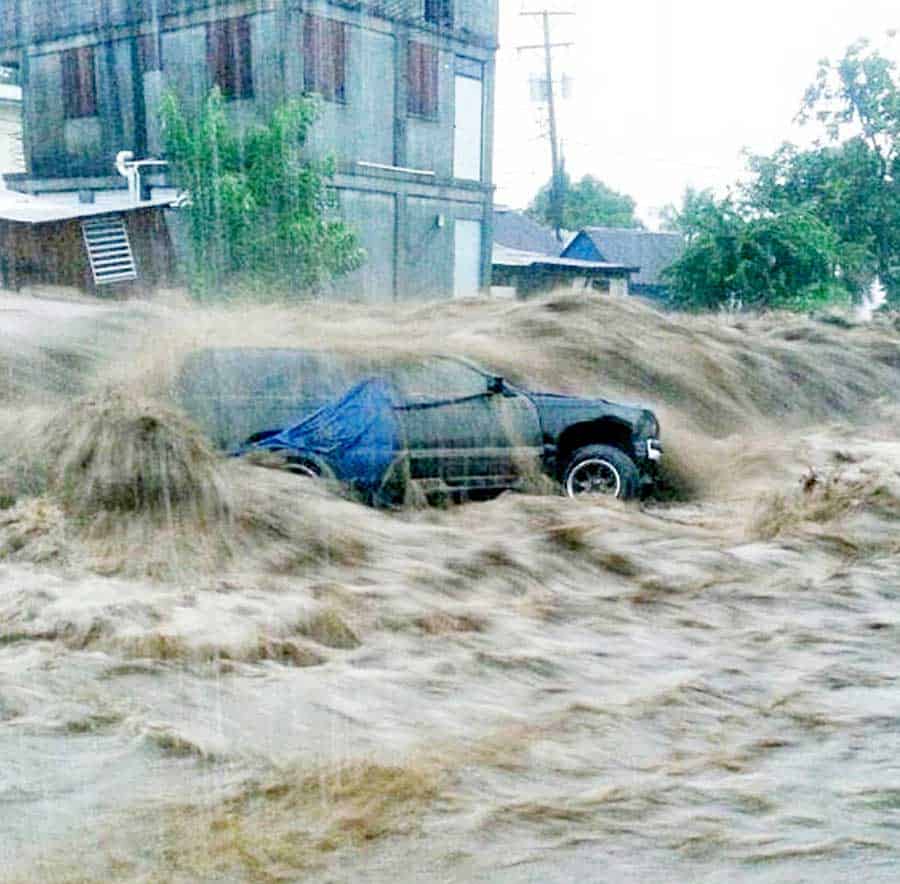
Above: Floodwaters cover streets in Dominica during Hurricane Maria. Photographer unknown.
BitDepth#1112 for September 26, 2017
At this point, nobody in T&T can say they didn’t know what would happen. The consequences of natural disaster in nations both well prepared and marginally ready are writ large across headlines and leading broadcasts the world over the last two weeks.
Despite our most vocal protestations that “God is a Trini,” that fundamental absurdity that’s been underwritten by the incidental geographical fact that our islands lie just outside the normal path of hurricanes forming in the mid-Atlantic, we know that we are not ready for the destruction that massive earthquakes and higher category windstorms bring to a small landmass.
The evidence is there in the results of any sustained rainfall on these islands, the muddy floods that quickly swamp our deepest drainage systems, the rapid rising of filthy water into homes and covering roadways.
One quick glance at the overcrowded poles that loom over our heads should be enough to let us know that the destruction that’s bedeviled the islands of this archipelago and the coastal cities of the US will extract a terrible cost from this country, when, and not if it happens.
The images and video clips from Mexico, Barbuda and Dominica are particularly terrible.
In Mexico, one solid looking building shakes once, twice, then simply disappears in a rising cloud of dust. Overhead images of Barbuda show an island simply wiped clean of human habitation. The occasional stubborn structure still stands; its walls stripped.
In Dominica, trees clog the streets, ripped from the earth or cracked in mid-trunk, they are shorn of their bark and their solid cores shredded.
If these scenes seem unimaginable, then it’s because disaster preparedness is the business of imagining the darkest possible outcomes of nature’s fury and planning for them effectively.
On Thursday, the Telecommunications Authority (TATT) will host a forum to discuss one element of those preparations, the emergency communications plan.
This arises from the call for consultation on the National Emergency Communications Plan, which is currently soliciting responses and advice from the national community on the measures proposed for managing communication during official disaster response.
The document itself is broadly sensible in its approach to discussing the elements of a failsafe communications structure in the wake of a disaster event in which little in the way of telecommunications infrastructure is left standing.
Communication before a disaster can make use of all the existing facilities that we take for granted, free-to-air broadcasting, social media, even, as the document rather hopefully notes, faxes.
It’s after the event that more serious consideration has to be brought to bear.
The day-long communications blackout in Dominica is one example of what can happen when modern transmission and relay systems are destroyed.
The Office of Disaster Prevention and Management (ODPM) owns and operates two VHF land mobile radio networks and one high-frequency radio station in Trinidad while the Tobago Emergency Management Agency (TEMA) owns and operates one VHF network and one HF station in Tobago.
The system is tested daily, but coverage is, according to the consultation document, “limited by geographical and propagation constraints and therefore some areas of the country cannot be accessed by these networks.”
The areas which cannot be covered are not listed in the consultative document.
Both agencies can create a wide area network (WAN) with the Ministry of National Security to coordinate emergency efforts and this system is presumed to also be regularly tested.
The document sensibly proposes an upgrade to the existing system with provisions for both a secure communications centre capable of withstanding disaster conditions and mobile transmission repeaters that can be deployed to improve signal strength in the wake of a disaster.
The document also seeks to establish a nationwide public safety WAN capable of transferring high-bandwidth data, allowing roving emergency responders to share real-time voice, video and data. There is no cost suggested for this First World system in the document.
More useful, as shown by the value of amateur licensed (HAM) radio operators in the immediate aftermath of Dominica’s tragedy, is the need to clearly establish proper protocols for the use of the frequencies allocated for amateur use, inclusive of the Citizen’s Band.
Regional experience over the last two weeks also proves that the first formal communications to be restored on even a limited basis is SMS based text messaging. Protocols for managing the limited bandwidth available in such circumstances should also be part of the emergency communications plan.
The plan also rather hopefully insists that “television broadcasters shall upgrade their facilities so that they are resilient to natural disasters and adopt improved technologies to facilitate efficient public notifications and warnings.”
This simply isn’t going to happen if it isn’t made a condition of the award or renewal of a broadcast license.
Ditto for the insistence that: “Cellular Mobile Operators shall maintain at least two transportable cells on wheels which shall be deployed with at least one in Trinidad and one in Tobago. These are to be reserved for emergency relief operations.”
In the medium term, looking beyond the immediate provisions of this plan, a firm proposal to move overhead cables to fortified underground routing in appropriate geographic locations would represent the bold thinking needed for forward looking local disaster preparedness in our communications infrastructure.
[Editor’s Note:] ECLAC has documented natural disaster related experiences and strategy in this document , which we reported on here in June, 2017. Lead author Robert Williams is currently in the Bahamas, we are advised, to conduct damage assessments in Caribbean islands after Irma and Maria.




I’m just uncertain how many times we will write what, basically, is the same thing… I would like to think that someone is actually doing more than posturing.
and honestly, I’m thinking that where the government consistently fails there is an opportunity for the private sector.